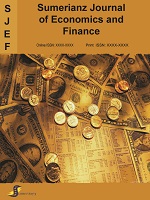Sumerianz Journal of Economics and Finance

Online ISSN: 2617-6947
Print ISSN: 2617-7641
Quarterly Published (4 Issues Per Year)
Journal Website: https://www.sumerianz.com/?ic=journal-home&journal=26Archive
Volume 4 Issue 2 (2021)
Research on Operating Efficiency of Security Companies Based on Super-Efficiency DEA-Malmquist Index
Authors : Lu He ; Guohui Huang ; Wenjing Xie ; Qianling Zeng ; Dr. Wen-Tsao Pan
DOI : doi.org/10.47752/sjef.42.90.95
Abstract:In China’s economic system, security companies are important participants, and their high operating efficiency can improve the country’s economy. Based on the traditional CCR-DEA model, this paper uses super-efficiency DEA model and MALMQUIST index model to analyze the operational efficiency of 10 listed security companies in China from 2016 to 2020, it is found that the operating efficiency of security companies as a whole has a slight upward trend, and the improvement of business efficiency depends on technical efficiency, and relates to pure technical efficiency and scale efficiency.
Asymmetric Dynamics of Industrial Response to Exchange Rate Variation in Nigeria
Authors : Iganiga B. O. ; Anyanwu U. N. ; Ojima D.
DOI : doi.org/10.47752/sjef.42.81.89
Abstract:Exchange rate policies are germane to industrial subsector development and the country at large. In this regard; the study examines the asymmetric pass through of official exchange rate policy on Nigerian industrial Subsector from 1970Q1 to 2019Q4. Non-linear ARDL method of estimation was adopted to ascertain the long run and short run asymmetric relation between official exchange rate and industrial output subsector. The results confirmed the presence of both long run and short run asymmetries between manufacturing output and official exchange rate. In the long run, increase in official exchange rate (appreciation) portends a corresponding increase in manufacturing output, while decrease in official exchange rate (depreciation) is negatively related to manufacturing output. On the other hand, the short run dynamics revealed that positive changes in official exchange rate choked off industrial output though statistically insignificance while negative change (depreciation) crowded in industrial output in Nigeria in the period under review against a priori expectation. The result also indicated that the crowding out impact of official exchange rate depreciation is more enduring (long lasting) compared to the positive variations. The presence of asymmetry is novel and instructive for policy pundits, executors, theorists, monetary authorities and allied agents to take decisive steps in order to stem the debilitating effects of exchange rate misalignment to encourage domestic investors, attract foreign investors and thus, stimulate the industrial subsector.
Socio-Economic Impact of Covid-19 Pandemic and Strategies for Reviving Nigeria’s Economy
Authors : Christopher Eyioma Alozie ; Abel O. Ideh ; Innocent Ifelunini
DOI : doi.org/10.47752/sjef.42.64.80
Abstract:This study provides multi-disciplinary assessment of coronavirus pandemic transmission in Nigeria, magnitude of confirmed cases, recoveries, deaths, and inventory of infected person with recovery lags. It applied the statistical outcomes in predicting spilling over to subsequent periods. It identifies economic sectors worst hit by COVID-19 triggered recession, simulate the estimates of potential fiscal and other macroeconomic impact of the pandemic in the country in short run alongside synthesis of restoration and sustainability strategies. Secondary data relating to coronavirus infection cases, spreads, recoveries and fatalities were assessed, using the susceptible-infected-recovered” (SIR) model in absence of mass testing and probable cessation from health crisis management. It identified economic sectors/activities being devastated by COVID-19 induced recession, provides interim estimates adverse impact based on economic peak and down-turn cycle method. The study also measured the magnitude of macroeconomic shocks in Nigeria’s economy using a standard global computable general equilibrium model and exploration of sustainability strategies based on synthesis of extant reports were employed. These data-sets were obtained from the Nigerian sources and partly from global sources. Furthermore, it utilized trend analysis derived from empirical data of extant daily confirmed cases, discharges and hospitalized person together with tentative projection of additional confirmed cases as from July–September, 2020. Results revealed that confirmed cases in Nigeria will increase steadily from 25694 (in June) to around 74825 by the end September and expected to reach 121000 by end of year 2020. This suggests that the pandemic is likely to persist up to the second quarter of 2021. Education, transport (aviation), hospitality, tourism and sports businesses; trade (informal sector) in the services sector; petroleum exploration in mining sub-sector are most severely contracting activities industries in the economy. Given the prevailing intensity of recession, the result indicates that a reduction of about 5-to-7% in GDP will be recorded in 2020. Result of variance analysis of fiscal budget estimates indicates adverse increase of -2% or more in overall fiscal deficit balances during the periods, which may aggravate debt burden with decline of about -5.7 percent and up to -7 percent in nominal GDP. Health, education, agriculture, petroleum exploration; petroleum refining and petrochemical industries, manufacturing (particularly pharmaceuticals), energy and power generation should be given priority in the sustainability programme.



